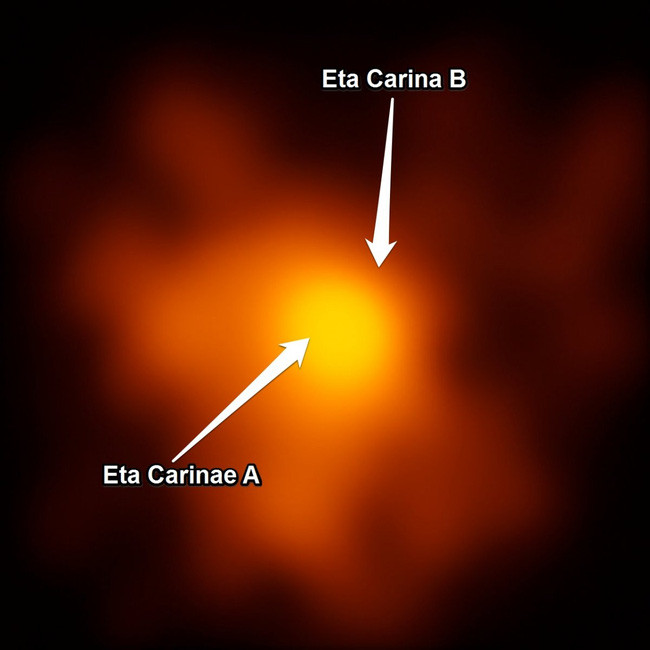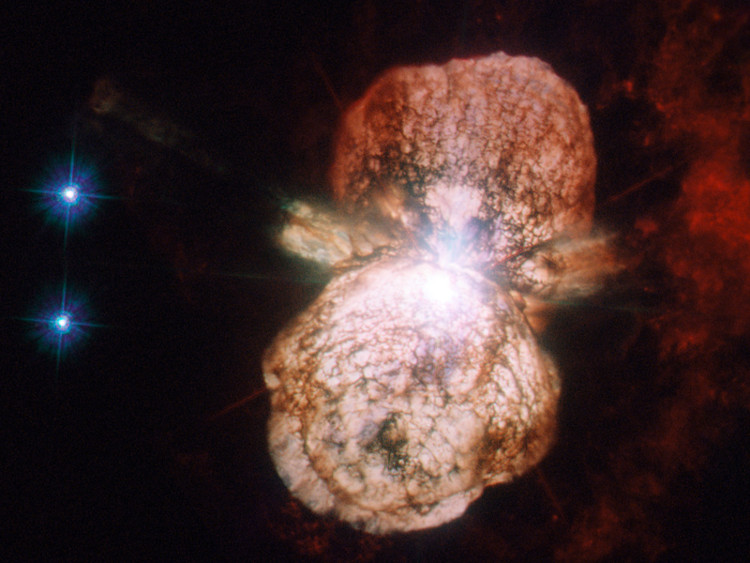The battle between two stars creates the brightest nebula in the Milky Way
The researchers first published images of the most intense battle of the Milky Way between the two stars, creating strong winds of 10 million km / h hours and a heat of 50 million degrees Celsius.
Two of the largest stars in the Milky Way lie in the binary star system Eta Carinae, 7,500 light-years from Earth, engaged in a fierce battle that lasts for millennia, according to Science Alert.

Photos of ESO show activity inside the star system Eta Carinae.(Photo: ESO).
In a study published Oct. 19 in Astronomy & Astrophysics, astronomers first photographed the core of Eta Carinae with the highest resolution, confirming the hypothesis of what's going on inside the system. this star
Eta Carinae is sometimes called "supernova standard" because the movement of two stars in the system is so strong that it is almost equivalent to the exploding stars. The most recent major outbreak, known as the Great Eruption, occurred in 1837, which lasted for 18 years and led to the birth of a brighter Homunculus nebula than any object in the Milky Way.
Astronomers are still unclear about the cause of the outbreaks, but Eta Carinae continues to produce wind full of gas and dust with speeds of up to 10 million km / h. The computer model of the US Aeronautics and Aeronautics Agency shows that these winds maintain and shape the nebula, but no scientist has found the mechanism of the process.
Eta Carinae B , the smaller star in the system, has 30 times the mass of the Sun and a million times brighter. Meanwhile, Eta Carinae A is 90 times heavier than the Sun and 5 million times brighter.

The Homunculus dumbent nebula covered the star system Eta Carinae.(Photo: NASA).
Every 5.5 years, the two stars move closer to each other, with the same distance from Mars to the Sun (about 228 million km). That time is called "subtle" (periastron) . The latest subtle approach occurred in August 2014, successfully recorded by the large Telescope at the Southern European Observatory (ESO).
The picture is not really clear, but confirms the intense battle on Eta Carinae . Each star inside the binary system releases extremely powerful molecular winds, pushing the temperature to 50 million degrees Celsius. The dust and gas from both sides form a dumb-shaped nebula that surrounds both stars.
"Our dream has come true," said Gerd Weigelt, an astronomer at the Max Planck Institute in Germany. "Although there are no sharp pictures, this is a unique opportunity to increase the knowledge of Eta Carinae and many other objects in the universe."
- How to see the Milky Way?
- The complex structure of the nebula is brightest in space
- Why is our galaxy called the Milky Way?
- Close up of the Milky Way's
- The halo in the galaxy is full of stars
- Detecting dust belt in Orion nebula
- Officially announced 3D Nebula model NGC 2440
- The giant area proliferates new stars
- Detect extremely bright stars in the sky
- Strange star groups move rapidly to disturb the Milky Way
- Orion Nebula, the cradle is full of disturbance
- Detects 5 oversized stars on galaxies
 Van Allen's belt and evidence that the Apollo 11 mission to the Moon was myth
Van Allen's belt and evidence that the Apollo 11 mission to the Moon was myth The levels of civilization in the universe (Kardashev scale)
The levels of civilization in the universe (Kardashev scale) Today Mars, the sun and the Earth are aligned
Today Mars, the sun and the Earth are aligned The Amazon owner announced a secret plan to build a space base for thousands of people
The Amazon owner announced a secret plan to build a space base for thousands of people